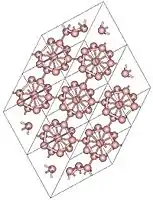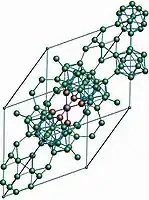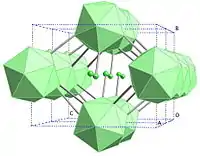Allotropie du bore
Le bore peut être préparé sous de nombreuses formes allotropiques, amorphes et cristallines. Les formes cristallines bien connues sont la forme α rhomboédrique, la forme β rhomboédrique et la forme β tétragonale. Sous des conditions particulières, le bore peut aussi être synthétisé sous la forme α tétragonale et la forme γ orthorhombique. Deux formes amorphes sont également connues, l'une ayant l'aspect d'une poudre finement divisée et l'autre ayant un aspect vitreux[1],[2]. Bien qu'au moins quatorze allotropes supplémentaires ont été signalés, les existences de ces autres formes sont basées sur des indices ténus ou n'ont pas été expérimentalement confirmées. Des mélanges d'allotropes ou des structures stabilisées par des impuretés sont également envisagés[3],[2],[4],[5]. Alors que la phase β rhomboédrique et la plus stable et les autres sont métastable, le rythme de transformation est négligeable à température ambiante : les cinq phases cristallines peuvent ainsi exister sous conditions ambiantes. La poudre amorphe et la phase β rhomboédrique polycristalline sont les formes les plus communes. Ce dernier est un matériau gris de dureté importante, environ dix pour cent plus léger que l'aluminium et avec un point de fusion de 2 080 °C[6].

Enfin depuis 2014, il existe de nombreuses formes de borosphérène qui sont autant de nouveaux allotropes de bore.
Propriétés
| Phase du bore | α-R | α-T | β-R | β-T | γ | Amorphe | |
|---|---|---|---|---|---|---|---|
| Poudre | Vitreux | ||||||
| Système cristallin | Rhomboédrique | Tétragonal | Rhomboédrique | Tétragonal | Orthorhombique | ||
| Occurrence | commun | particulier | commun | commun | particulier | ||
| Atomes par maille simple[7] | 12 | 50 | 105‒108 | 192 | 28 | ||
| Masse volumique (g/cm3)[1] | 2,46 | 2,29‒2,39[8] | 2,35 | 2,36 | 2,52 | 1,73 | 2,34–2,35 |
| Dureté Vickers (GPa)[9],[10] | 42 | 45 | 50–58 | ||||
| Module d'élasticité isostatique (GPa)[10][11] | 224 | 184 | 227 | ||||
| Bande interdite (eV) | 2[12] | 1,6[13] | ~2,6[14] | 2,1[10] | 0,56–0,71[15] | ||
| Couleur | Les cristaux sont rouge clais[16] | Noir et opaque, avec un lustre métallique[17] | Sombre à gris-argent brillant[1],[2] | Noir/rouge[n 1],[18] | Gris sombre[19] | Noir à brun[n 2] | Noir opaque[1] |
| Année de découverte[20] | 1958 | 1943/1973[n 3] | 1957 | 1960 | 2009 | 1808 | 1911[21],[22] |
 Structure de la forme α-R du bore.
Structure de la forme α-R du bore. Structure de la forme β-R du bore.
Structure de la forme β-R du bore. Structure de la forme γ du bore.
Structure de la forme γ du bore.
Notes et références
Notes
- (en) Cet article est partiellement ou en totalité issu de l’article de Wikipédia en anglais intitulé « Allotropes of boron » (voir la liste des auteurs).
- Noir lorsqu'observé par une lumière réfléchie ; rouge par lumière transmise.
- La poudre de bore amorphe de grande pureté est noire tandis que les échantillons plus impurs ont un aspect brun : Lidin R. A. (1996). Inorganic substances handbook. New York: Begell House. p. 22 ; (en) V. S. Zenkov, « Adsorption-chemical activity of finely-dispersed amorphous powders of brown and black boron used in synthesizing metal borides », Powder Metallurgy and Metal Ceramics, vol. 45, nos 5–6, , p. 279–282 (279) (DOI 10.1007/s11106-006-0076-z) ; (en) V. E. Loryan, I. P. Borovinskaya et A. G. Merzhanov, « On combustion of boron in nitrogen gas », International Journal of Self-Propagating High-Temperature Synthesis, vol. 20, no 3, , p. 153–155 (DOI 10.3103/S106138621103006X) ; (en) G. I. Kanel, A. V. Utkin et S. V. Razorenov, « Rate of the energy release in high explosives containing nano-size boron particles », Central European Journal of Energetic Materials, vol. 6, no 1, , p. 15–30 (18) (lire en ligne [PDF]).
- La structure a été théorisée en 1943 ; la première synthèse annoncée de la forme α tétragonale du bore a été réalisée en 1973 : Kunzmann, P. M. (1973). Structural studies on the crystal chemistry of icosahedral boron framework structure derivatives. PhD thesis. Cornell University; Amberger, E. (1981). "Elemental boron". In Buschbeck, K. C.. Gmelin handbook of inorganic and organometallic chemistry: B Boron, Supplement 2 (8th ed.). Berlin: Springer-Verlag. pp. 1–112 (60–61). (ISBN 3-540-93448-0).
Références
- Wiberg 2001, p. 930.
- Housecroft et Sharpe 2008, p. 331.
- Donohue 1982, p. 48.
- T. Lundström, « The solubility in the various modifications of boron », dans T. LundströmJ. J. Zuckerman, A. P. Hagen, Inorganic reactions and methods, New York, coll. « Vol. 13: The formation of bonds to group-I, -II, and -IIIB elements », , 196–97 p. (ISBN 0-470-14549-8).
- Oganov et al. 2009, p. 863.
- (en) D. R. Lide (dir.), CRC Handbook of Chemistry and Physics, 84th Edition, Boca Raton, Florida, CRC Press, , « Section 4-116, Properties of the Elements and Inorganic Compounds; Melting, boiling, and critical temperatures of the elements ».
- Oganov et al. 2009.
- Amberger 1981, p. 60.
- (en) V. L. Solozhenko, O. O. Kurakevych et A. R. Oganov, « On the hardness of a new boron phase, orthorhombic γ-B28 », Journal of Superhard Materials, vol. 30, no 6, , p. 428–429 (DOI 10.3103/S1063457608060117).
- Zarechnaya et al. 2009.
- Nelmes et al. 1993.
- Madelung 1983, p. 10.
- Madelung 1983, p. 11.
- (en) Y. Kumashiro (dir.), Electric Refractory Materials, New York, Marcel Dekker, , 589‒654 (633, 635) (ISBN 0-8247-0049-X), « Boron and boron-rich compounds ».
- Madelung 1983, p. 12.
- Donohue 1982, p. 57.
- (en) J. L. Hoard, R. E. Hughes et E. L. Muetterties (dir.), The chemistry of boron and its compounds, New York, John Wiley & Sons, , 25–154 (29, 82), « Chapter 2: Elementary boron and compounds of high boron content: Structure, properties and polymorphism ».
- Donohue 1982, p. 78.
- Oganov et al. 2009, p. 863–64.
- Donohue 1982, p. 48, 57, 61.
- (en) E. Weintraub, « On the properties and preparation of the element boron », The Journal of Industrial and Engineering Chemistry, vol. 3, no 5, , p. 299–301 (299) (DOI 10.1021/ie50029a007) :
« Both in appearance and in its curved conchoidal fracture the lump and the broken-up pieces most nearly resemble black diamond ... with an amorphous structure. »
. - (en) A. W. Laubengayer, A. E. Brandaur et R. L. Brandaur, « Progress in the preparation and determination of the properties of boron », Journal of Chemical Education, vol. 19, no 8, , p. 382–85 (DOI 10.1021/ed019p382, Bibcode 1942JChEd..19..382L) :
« Boron ... shows a considerable tendency to assume the vitreous condition ... Volatile compounds of boron such as the halides and the hydrides have been decomposed by passing their vapors through an arc or by bringing them in contact with a hot surface or filament. Boron of high purity is reported procurable by this method, but it is either a very fine powder or of vitreous structure. »
.
Bibliographie
- (en) E. Amberger et K. C. Buschbeck (dir.), Gmelin handbook of inorganic and organometallic chemistry : B Boron, Supplement 2, Berlin, Springer-Verlag, , 8e éd., 1–112 p. (ISBN 3-540-93448-0), « Elemental boron »
- (en) J. Donohue, The structures of the elements, Malabar, Florida, Robert E. Krieger, (ISBN 0-89874-230-7)
- (en) C. E. Housecroft et A. G. Sharpe, Inorganic chemistry : solutions manual, Harlow, Pearson Education, , 3e éd., 368 p. (ISBN 978-0-13-175553-6, lire en ligne)
- (en) O. Madelung, Landolt-Bornstein numerical data and functional relationships in science and technology. New series. Group III. Volume 17 : Semiconductors. Subvolume e : Physics of non-tetrahedrally bonded elements and binary compounds I, Springer-Verlag: New York, (ISBN 0-387-11780-6)
- (en) R. J. Nelmes, J. S. Loveday, D. R. Allan, J. M. Besson, G. Hamel, P. Grima et S. Hull, « Neutron- and x-ray-diffraction measurements of the bulk modulus of boron », Physical Review B, vol. 47, no 13, , p. 7668–7673 (DOI 10.1103/PhysRevB.47.7668, Bibcode 1993PhRvB..47.7668N)
- (en) A. R. Oganov, J. Chen, Y. Ma, C. W. Glass, Z. Yu, O. O. Kurakevych et V. L. Solozhenko, « Ionic high-pressure form of elemental boron », Nature, vol. 457, no 7027, , p. 863–868 (PMID 19182772, DOI 10.1038/nature07736, Bibcode 2009Natur.457..863O, arXiv 0911.3192)
- (en) D. B. Sullenger, K. D. Phipps, P. W. Seabaugh, C. R. Hudgens, D. E. Sands et J. S. Cantrell, « Boron modifications produced in an induction-coupled argon plasma », Science, vol. 163, no 3870, , p. 935‒937 (PMID 17737317, DOI 10.1126/science.163.3870.935, Bibcode 1969Sci...163..935S)
- (en) C. P. Talley, S. La Placa et B. Post, « A new polymorph of boron », Acta Crystallographica, vol. 13, no 3, , p. 271‒2 (DOI 10.1107/S0365110X60000613)
- (en) Y. Q. Wang et X. F. Duan, « Crystalline boron nanowires », Applied Physics Letters, vol. 82, no 2, , p. 272 (DOI 10.1063/1.1536269, Bibcode 2003ApPhL..82..272W)
- (en) R. H. Wentorf, « Boron: Another form », Science, vol. 147, no 3653, , p. 49–50 (PMID 17799779, DOI 10.1126/science.147.3653.49, Bibcode 1965Sci...147...49W)
- (en) N. Wiberg, Inorganic chemistry, San Diego, Academic Press, (ISBN 0-12-352651-5)
- (en) G. Will et B. Kiefer, « Electron deformation density in rhombohedral α-boron », Zeitschrift für anorganische und allgemeine Chemie, vol. 627, no 9, , p. 2100‒104 (DOI 10.1002/1521-3749(200109)627:9<2100::AID-ZAAC2100>3.0.CO;2-G)
- (en) E. Y. Zarechnaya, L. Dubrovinsky, N. Dubrovinskaia, Y. Filinchuk, D. Chernyshov, V. Dmitriev, N. Miyajima, A. El Goresy et H. Braun, « Superhard semiconducting optically transparent high pressure phase of boron », Physical Review Letters, vol. 102, no 18, , p. 185501‒4 (PMID 19518885, DOI 10.1103/PhysRevLett.102.185501, Bibcode 2009PhRvL.102r5501Z)
- Portail de la chimie